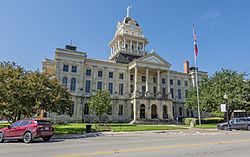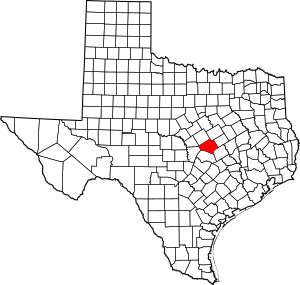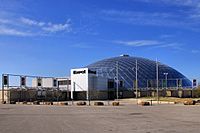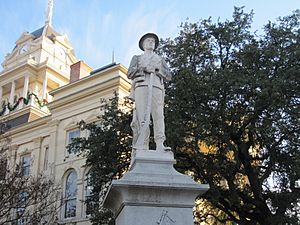Bell County, Texas facts for kids
Quick facts for kids
Bell County
|
|
|---|---|

The Bell County Courthouse in Belton
|
|

Location within the U.S. state of Texas
|
|
 Texas's location within the U.S. |
|
| Country | |
| State | |
| Founded | 1850 |
| Named for | Peter Hansborough Bell |
| Seat | Belton |
| Largest city | Killeen |
| Area | |
| • Total | 1,088 sq mi (2,820 km2) |
| • Land | 1,051 sq mi (2,720 km2) |
| • Water | 37 sq mi (100 km2) 3.4% |
| Population
(2020)
|
|
| • Total | 370,647 |
| • Density | 340.67/sq mi (131.53/km2) |
| Time zone | UTC−6 (Central) |
| • Summer (DST) | UTC−5 (CDT) |
| Congressional districts | 11th, 31st |
Bell County is a place in Texas, United States. It's located in the middle part of Texas. The main town, called the county seat, is Belton.
In 2020, about 370,647 people lived in Bell County. It's part of a bigger area that includes the cities of Killeen and Temple.
Bell County was started in 1850. It's named after Peter Hansborough Bell, who was the third governor of Texas. In 2010, the exact middle point of where people live in Texas was found in Bell County, near a town called Holland.
Contents
History of Bell County
Bell County has a long and interesting history, from its first settlers to modern times.
Early Settlements and Growth
- 1834–1835: The area around Little River became part of Robertson's Colony. Settlers from Nashville arrived, led by Sterling C. Robertson.
- 1836: Settlements were left empty during the "Runaway Scrape," a time when people fled from fighting. They were later reoccupied. A Texas Ranger named George Erath built a fort on Little River.
- 1843–1844: More settlers returned to the area.
- 1845: The University of Mary Hardin–Baylor was founded by the Republic of Texas. It was first called “Baylor Female College.”
- 1850: Bell County was officially formed. It was named after Texas Governor Peter Hansborough Bell. At this time, about 600 white people and 60 enslaved black people lived here.
- 1851: Belton was chosen as the county seat, the main town for county government.
- 1859: The last major Native American raid happened in the area.
- 1860: The border between Bell and Milam County was officially set, giving Bell County its current shape.
Civil War and Reconstruction
- 1861: The county voted to leave the Union and join the Confederacy.
- 1862–1865: During the American Civil War, some people who supported the Union or were soldiers who left the Confederate army hid in a place called "Camp Safety."
- 1867: The Belton Women’s Commonwealth was formed. This was the first women's group in Central Texas. It helped women who were in difficult situations.
- 1865–1877: After the Civil War, during a time called Reconstruction, there were some difficult times in the county. Federal troops were stationed in Belton to help keep order.
Modern Era and Growth
- 1875: Miriam A. Ferguson, who would become the first woman governor of Texas, was born in Bell County.
- 1881: The Gulf, Colorado and Santa Fe Railway was the first railroad built in Bell County. It made Temple its main office.
- 1884: The current Bell County Courthouse was built. It was designed by architect Jasper N. Preston and his sons.
- 1905: An electric railway, called the Interurban, was built between Belton and Temple.
- 1925: Miriam A. Ferguson became the governor of Texas.
- 1926: Temple Junior College, now called Temple College, opened.
- 1933: Miriam A. Ferguson became governor again for a second time.
- 1942: Fort Hood opened as a military training base.
- 1956: The Killeen school board decided to allow students of all races to attend the local high school.
- 1965: Central Texas College was founded in Killeen.
- 1976: The Temple Mall shopping center opened.
- 1980: Killeen became the largest city in Bell County.
- 1981: The Killeen Mall shopping center opened.
- 1987: The Bell County Expo Center opened.
Geography of Bell County
Bell County is a large area in Central Texas.
Land and Water
According to the U.S. Census Bureau, Bell County covers about 1,088 square miles. Most of this (1,051 square miles) is land. About 37 square miles, or 3.4%, is water.
Neighboring Counties
Bell County shares its borders with several other counties:
- McLennan County (to the north)
- Falls County (to the northeast)
- Milam County (to the southeast)
- Williamson County (to the south)
- Burnet County (to the southwest)
- Lampasas County (to the west)
- Coryell County (to the northwest)
People of Bell County
Bell County has grown a lot over the years. Here's a look at its population and the different groups of people who live there.
Population Growth
| Historical population | |||
|---|---|---|---|
| Census | Pop. | %± | |
| 1860 | 4,799 | — | |
| 1870 | 9,771 | 103.6% | |
| 1880 | 20,518 | 110.0% | |
| 1890 | 33,377 | 62.7% | |
| 1900 | 45,535 | 36.4% | |
| 1910 | 49,186 | 8.0% | |
| 1920 | 46,412 | −5.6% | |
| 1930 | 50,030 | 7.8% | |
| 1940 | 44,863 | −10.3% | |
| 1950 | 73,824 | 64.6% | |
| 1960 | 94,097 | 27.5% | |
| 1970 | 124,483 | 32.3% | |
| 1980 | 157,889 | 26.8% | |
| 1990 | 191,088 | 21.0% | |
| 2000 | 237,974 | 24.5% | |
| 2010 | 310,235 | 30.4% | |
| 2020 | 370,647 | 19.5% | |
| 2023 (est.) | 393,193 | 26.7% | |
| U.S. Decennial Census 1850–2010 2010 2020 |
|||
In 2010, about 310,235 people lived in Bell County. There were about 114,035 households, which are groups of people living together. The population density was about 295 people per square mile.
Diversity in Bell County
Bell County is home to many different groups of people. In 2010, the racial makeup was:
- 61.4% White
- 21.5% Black
- 0.8% Native American
- 2.8% Asian
- 0.8% Pacific Islander
- 5.0% from two or more races.
About 21.6% of the population was Hispanic or Latino. This group includes people of any race.
| Race / Ethnicity (NH = Non-Hispanic) | Pop 2000 | Pop 2010 | Pop 2020 | % 2000 | % 2010 | % 2020 |
|---|---|---|---|---|---|---|
| White alone (NH) | 136,241 | 157,289 | 156,780 | 57.25% | 50.70% | 42.30% |
| Black or African American alone (NH) | 47,344 | 63,380 | 80,759 | 19.89% | 20.43% | 21.79% |
| Native American or Alaska Native alone (NH) | 1,297 | 1,484 | 1,448 | 0.55% | 0.48% | 0.39% |
| Asian alone (NH) | 5,935 | 8,350 | 10,884 | 2.49% | 2.69% | 2.94% |
| Pacific Islander alone (NH) | 1,005 | 2,245 | 3,454 | 0.42% | 0.72% | 0.93% |
| Other race alone (NH) | 479 | 500 | 2,063 | 0.20% | 0.16% | 0.56% |
| Mixed race or Multiracial (NH) | 5,972 | 9,977 | 21,792 | 2.51% | 3.22% | 5.88% |
| Hispanic or Latino (any race) | 39,701 | 67,010 | 93,467 | 16.68% | 21.60% | 25.22% |
| Total | 237,974 | 310,235 | 370,647 | 100.00% | 100.00% | 100.00% |
Household Information
In 2010, about 40% of households had children under 18 living with them. The average household had 2.68 people. The median age in the county was 29 years old. This means half the people were younger than 29, and half were older.
The average income for a household in the county was about $36,872. About 12% of the population lived below the poverty line.
Education in Bell County
Bell County has many different school districts that serve its students.
School Districts
Here are some of the school districts in Bell County:
- Academy Independent School District
- Bartlett Independent School District (part of it)
- Belton Independent School District
- Bruceville-Eddy Independent School District (part of it)
- Copperas Cove Independent School District (part of it)
- Florence Independent School District (part of it)
- Gatesville Independent School District (part of it)
- Holland Independent School District (part of it)
- Killeen Independent School District (part of it)
- Lampasas Independent School District (part of it)
- Moody Independent School District (part of it)
- Rogers Independent School District (part of it)
- Rosebud-Lott Independent School District (part of it)
- Salado Independent School District
- Temple Independent School District
- Troy Independent School District
Colleges
- Central Texas College serves areas like Killeen ISD and Fort Hood.
- Temple Junior College serves areas like Academy ISD, Belton ISD, and Temple ISD.
Transportation in Bell County
Getting around Bell County is made easier by major highways and public transport.
Major Highways
Several important highways run through Bell County:
 Interstate 14 and
Interstate 14 and  U.S. Highway 190
U.S. Highway 190 Interstate 35
Interstate 35 State Highway 36
State Highway 36 State Highway 53
State Highway 53 State Highway 95
State Highway 95 State Highway 195
State Highway 195
Public Transportation
The Hill Country Transit District offers bus services in Killeen and Temple. They also have a special service for people who need extra help to get around the county. Amtrak also has train service to Temple.
Communities in Bell County
Bell County has many different cities, towns, and smaller communities.

Cities
- Bartlett (partly in Williamson County)
- Belton (the county seat)
- Copperas Cove (mostly in Coryell County and a small part in Lampasas County)
- Harker Heights
- Killeen
- Little River-Academy
- Morgan's Point Resort
- Nolanville
- Temple
- Troy
Towns
Village
Census-designated Place
- Fort Hood (partly in Coryell County)
Unincorporated Communities
These are smaller communities that are not officially part of a city or town.
See also
 In Spanish: Condado de Bell (Texas) para niños
In Spanish: Condado de Bell (Texas) para niños


